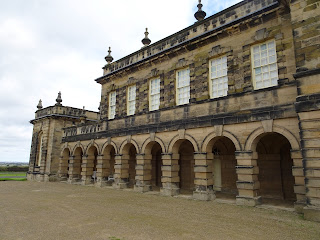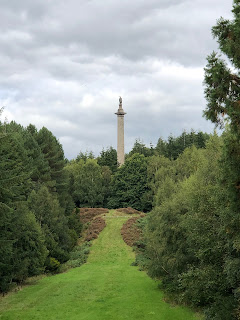This morning, we set out to the coast of Northumbria, to visit an estate that is known to have Norman origins. The Deleval family was gifted land in 1080 by William the Conqueror, and it is upon this land that Seaton Deleval Hall stands to this day.
The estate was purchased by Admiral George Delaval in the 1700s and he commissioned Sir John Vanbrugh to design this building in 1720. Both passed prior to his dream coming to fruition.
George's nephew, Francis, inherited Seaton Delaval Hall, and he and his wife, Rhoda, moved into the house where they raised their family. This painting depicts their seven living children.
The family was known for what was considered to be "outrageous" behavior to the people of that time. They hosted many parties and theatrical events.
Guests who were invited to stay the night would be shocked to find that mechanical hoists were installed in the house which would suddenly raise the bedroom walls, leaving them literally exposed to view from anyone nearby.
There was a bed which could be lowered into a tank of cold water, just by winding a handle in the adjacent room. And there was this curious "upside down room" which was able to be completely inverted.
Let's face it....this is all quite ridiculous for even present day, let alone in the 1700s.
The house was victim to a fire in 1822, and the entire one wing was left uninhabitable. The center living area of the house was damaged as well, and never underwent repairs to restore it to its original state. The family was able to continue to live on the remaining wing, which offered plenty of room for their needs.
One of the bedrooms featured a four poster bed, along with a high plumed hat, presumably used for one of the many theatrical events that had occurred thanks to Francis, the eldest son.
The center hall has a lovely black and white mosaic flooring, original to the house. One can peer up to see that there were two more floors that have never been restored. In this center hall space, a giant metal ball is hanging from the ceiling. There really is no significance to this giant ball, it is merely there as a quirky addition.
There is a unique staircase on each side of the house, leading to the upstairs, but no real rooms. Just a different vantage point to view the center hall.
There was a giant anchor in the basement, presumably due to the connection between the Delaval family and the Navy.
The stable still stands, with the name of each of the horses placed above their stalls.
Along the walls of the occupied wing, several gardens are on display.
Such an interesting array of flowers and plants to enjoy. We walked around the grounds, admiring the many vantage points the grounds had to offer.
We stopped for our daily "cuppa" and scone, then headed southwest to another National Trust Site: Gibside.
I had read that this place offered some enjoyable trails to walk, along with gardens, but I had not realized that Gibside is the ancestral home of the Queen Mother. We quickly learned that when one of the National Trust guides sought us out, after realizing that we were Americans, and as he put it, Americans love learning British history. And he certainly was correct in that analysis with these two Americans.
Gibside was a Jacobean mansion built in 1620. It stands as ruins on the grounds.
The Queen Mother's father, the 14th Earl of Strathmore, enjoyed spending time there as a child when it was very much a beautiful palace.
The land was inherited by George Bowes in 1722. He was a coal magnate with money to spend to create a magnificent property and he was responsible for creating the beautiful landscape garden, along with the Chapel designed by James Paine.
But, before I get ahead of myself, we decided to walk the liberty tour on the property, as it was 2 and a half miles long, and just about enough for my legs which were still remembering hiking Hadrian's wall just yesterday.
The tour begins in a walled garden, that features dozens of apple trees bursting with harvest. Along the way, there are several quilts displayed as flags, each depicting a different scene. Here is the apple tree in spring.
Here you can easily see the queen, enjoying a picnic, along with one of her precious corgies.
Summer is represented here, with air balloons in the sky.
and I absolutely loved the apples, represented by buttons in the color and shapes of the fruit.
So clever!
There were other plants among the trees, as you can see by this nearly ripe pumpkin
and nearly faded thistle.
Just outside the walled garden, along the trail, stands the ruins of the Orangery.
Such an amazing view overlooking fields scattered with sheep.
Opposite the chapel stands the Column to British Liberty. It was constructed in the mid 1700s by Bowes-Lyon. The female figure at the top was once covered in gold leaf.
Along the trail, there is a small pond with a house upon the hill that is not actually part of the estate.
and a bird hide, which proved to be a bit entertaining
The Liberty trail was a peaceful haven, leading us through the woods in a loop, then back to the "Avenue" with the Liberty Statue standing on a hill, to our backs, as we approached the chapel.
The interior is simple but lovely.
and at the entrance to the chapel, on the left, stands a simple memorial, with a book of remembrance that a visitor can choose to sign.
We signed the book, offering our condolences, and realized what a rare opportunity we had been gifted on this day. We are part of an event that will be written in history, preserved, as these special places of beauty have been preserved for future generations to enjoy.
And with that, I sign off to get some sleep. We will be moving towards the Lake District tomorrow as we begin another adventure. Be sure to stay tuned!











































No comments:
Post a Comment